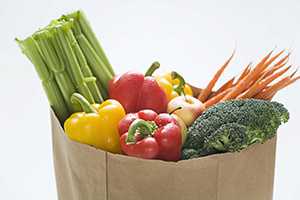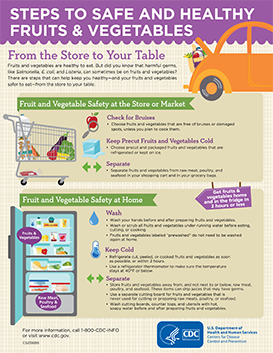Steps to Safe and Healthy Fruits & Vegetables
From the Store to Your Table
Fruits and vegetables are healthy to eat. But did you know that harmful germs, like Salmonella, E. coli, and Listeria, can sometimes be on fruits and vegetables? There are steps that can help keep you healthy—and your fruits and vegetables safer to eat—from the store to your table.
Fruit and Vegetable Safety at the Store or Market
Check for Bruises
- Choose fruits and vegetables that are free of bruises or damaged spots, unless you plan to cook them.
Keep Precut Fruits and Vegetables Cold
- Choose precut and packaged fruits and vegetables that are refrigerated or kept on ice.
Separate
- Separate fruits and vegetables from raw meat, poultry, and seafood in your shopping cart and in your grocery bags.
Fruit and Vegetable Safety at Home
Wash
- Wash your hands before and after preparing fruits and vegetables.
- Wash or scrub all fruits and vegetables under running water before eating, cutting, or cooking.
- Fruits and vegetables labeled “prewashed” do not need to be washed.
Keep Cold

Get fruits and vegetables home and in the refrigerator in 2 hours or less.
- Refrigerate cut, peeled, or cooked fruits and vegetables as soon as possible, or within 2 hours. Refrigerate within 1 hour if the temperature outside is above 90°F.
- Use a refrigerator thermometer to make sure the temperature stays at 40°F or below.
Separate
- Store fruits and vegetables away from, and not next to or below, raw meat, poultry, or seafood. These items can drip juices that may have germs.
- Use a separate cutting board for fruits and vegetables that is never used for cutting or preparing raw meats, poultry, or seafood.
- Wash cutting boards, countertops, and utensils with hot, soapy water before and after preparing fruits and vegetables.
- Page last reviewed: August 8, 2016
- Page last updated: August 8, 2016
- Content source:


 ShareCompartir
ShareCompartir
